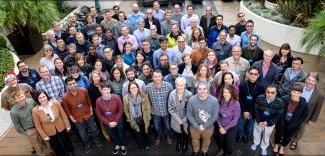The Next-Generation Ecosystem Experiments (NGEE Arctic) is a multi phase project (2012—2027) to improve our predictive understanding of tundra ecosystems at the top of the world. NGEE Arctic is a model-driven, multiscale research project that has built a foundation of model–data integration by leveraging a long history of tundra observations from generations of Arctic scientists and contributing new observations from a decade of field research in Arctic Alaska. NGEE Arctic emphasizes iterative collaboration among interdisciplinary teams of empiricists and modelers to incorporate observations and experiments into models (i.e., a ‘Mod-Ex’ philosophy), underscored by a culture of Team Science. Furthermore, NGEE Arctic promotes open science and data sharing across the project and throughout the broader scientific community as mandated by the Department of Energy’s Office of Science (DOE’s SC) and the Biological and Environmental Research (BER) program, Earth and Environmental Systems Sciences Division (EESSD).
The goal of NGEE Arctic is to support the DOE BER mission to advance a robust predictive understanding of Earth’s climate and environmental systems by delivering a process-rich ecosystem model, extending from bedrock to the interface between the vegetative canopy and the atmosphere, that can simulate the evolution of Arctic ecosystems at the scale of a high-resolution grid cell in DOE’s Energy Exascale Earth System Model (E3SM).
To achieve this ambitious goal, NGEE Arctic brought together a team of more than 100 scientists, spanning four national laboratories and the University of Alaska Fairbanks. In Phases 1–3, we conducted a series of collaborative investigations across a gradient of permafrost landscapes in coordination with landowners from multiple Native Corporations. These landscapes include polygonal tundra underlaid by continuous, cold permafrost on the coastal plain at the Barrow Environmental Observatory (BEO) outside of Utqiaġvik, Alaska, as well as tundra hillslopes underlaid by discontinuous, warmer permafrost on the Seward Peninsula, Alaska, that span a range of coastal and interior climates and glaciation histories.
In Phase 1 (2012—2014), our modeling approach was driven by the recognition that the current generation of Earth system models fails to capture many processes controlling the cycling of carbon, water, nutrients, and energy in Arctic tundra. Initial model improvements emphasized the unique aspects of cold, continuous permafrost environments and improved mechanistic model representation of coupled surface and subsurface thermal hydrology, biogeochemistry, and snow.
In Phase 2 (2015–2018), our multiscale modeling approach informed hypotheses about which reductions in model complexity were possible while retaining predictive power, and, in turn, which processes required the use of fine-scale model parameterizations to inform intermediate-scale models. We confronted our improved models with unique aspects of hillslope environments on warmer, discontinuous permafrost on the Seward Peninsula of Alaska.
In Phase 3 (2019–2024), we leveraged NGEE Arctic observations, synthesis products, and model scaling over space and time under a framework of six science questions to inform the conceptualization and parameterization of six integrated model modules in an 'Arctic-informed' land surface model, ELM.
In Phase 4 (2025–2027), we are using computational, artificial intelligence, remote-sensing, and data synthesis tools to test our newly-developed predictive understanding under novel conditions across the Arctic.


